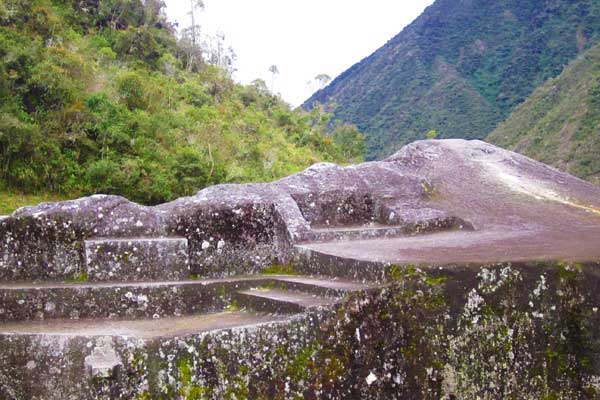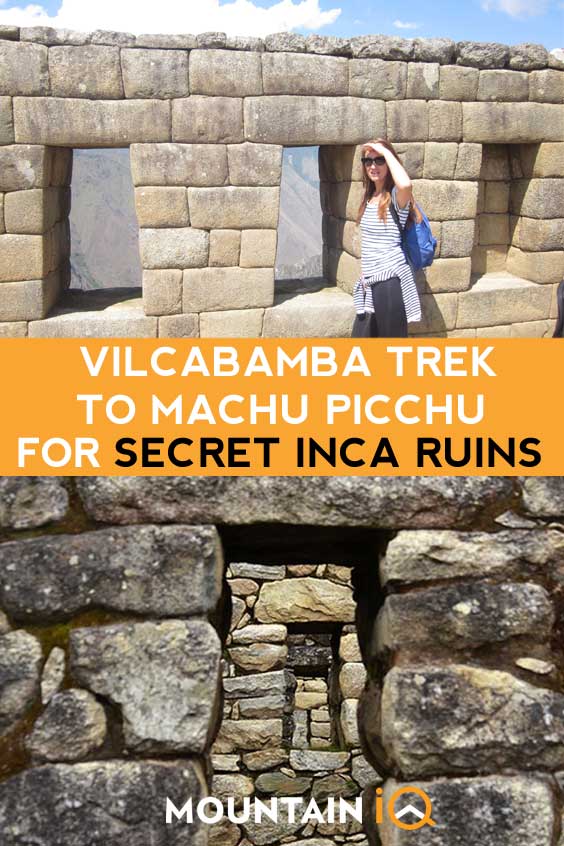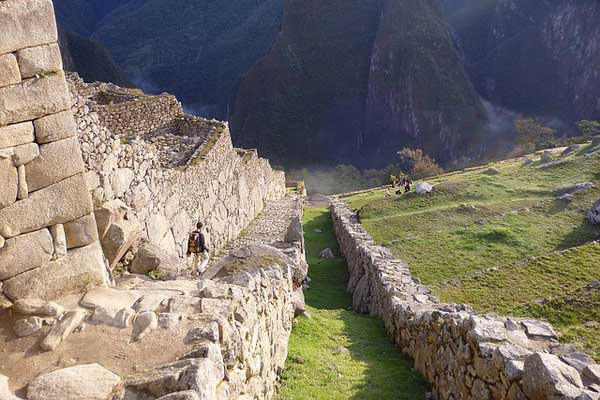If you are planning a hike to Machu Picchu and looking to do things a little differently, then the Vilcabamba hike may be perfect for you.
This page provides you with detailed information on your route options, the best time to embark on your Peruvian expedition through the Andes, helpful tips on avoiding altitude sickness, what to pack, how to train for the hike, and more.
Vilcabamba Trail Overview
Vilcabamba was founded in 1539 by Manco Inca and functioned as the capital of the Neo-Inca State until 1572 when the city fell to Spanish rule, as the Incan resistance to Spanish invasion was finally quashed.
The site is located on the Chontabamba River, off the Urubamba River, and should not be confused with the Spanish colonial town of Vilcabamba la Nueva.
The ancient capital was devastated by the invaders, abandoned, until eventually being rediscovered in 1911 and dubbed the “Lost City Of The Incas”.
The Vilcabamba Trek to Machu Picchu is one of the less common route options, so you can expect to use quiet trails with few fellow tourists.
Pro Tip: This is also one of the toughest treks to Machu Picchu, so we particularly recommend this, if you are looking for a culturally packed, scenically beautiful physical challenge without any tourists in sight!
Vilcabamba Trek Key Facts
- Difficulty: Most challenging of all the alternative treks to Machu Picchu
- Duration of Trek: 5 days
- Trek Distrance: 48km
- Maximum Altitude: 4,500m
- Accommodation: No facilities and no official campsites - depending on your point of view, this may add to the authenticity of your experience, or add to your general discomfort
- Best Time to Go: From May to September
- Permits: Not required other than for your visit to Machu Picchu

Typical Vilcabamba Trail Itinerary
The Vilcabamba trek to Machu Picchu is generally completed over 5 days, although alternatives to this structure are available.
Below we have summarised a typical itinerary, so that you can see what to expect day-by-day.
Day 1: Cusco to Huancacalle via Abra Malaga
Day 1 starts off with an early morning drive, leaving Cusco at about 4am.
You’ll drive through Ollantaytambo and stop for a quick break, and then continue all the way up and over the Abra Malaga Pass (4,316m) and on into the Vilcabamba valley to Santa Maria (1,890m).
The drive will likely conclude at Huancacalle, where you’ll set up camp for the night. There is the potential option of overnighting in a hostel, although most tour companies would have pre-arranged your camping spot.
There is the option of finishing off the day with an excursion to the archaeological ruins of VItcos-Rosaspata and the Ñustahispana.
Otherwise, you can hike there early on Day 2. In total, the drive takes about 8 hours, and the final hike about 2.
Day 2: Huancacalle to Racachaca
Day 2 starts with a steep climb up the Asuntina Pass (3,915m) which boasts impressive vistas of the river and valley below.
You will then follow an original Inca trail to Pillaukasa (3,860m), a little village above your campsite at Racachaca (3,570m). The day is an intensive day of hiking, and takes up to 12 hours in total.
Day 3: Racachaca to Mutuypata
Today is the most challenging of the Vilcabamba trek – you will be traversing 3 passes, which is no mean feat. Starting the climb up to Hatum Pampa (3,860m), the first pass you will conquer is the Yanococha (4,420m) which leads you down to Yanococha Lake.
Next, you’ll come up against the Tullu Tacanca Pass (4,500m) and finally the Abra Mujun Pass (4,100m).
From the peak of this third pass you will descend past the villages of S’aqra Cocha and Laccococha on to your campsite for the night at Mutuypata (3,000m).
Day 3 is known to get pretty muddy, especially during the rainy months from November till April, so make sure to pack gaiters.
Day 4: Mutuypata to Aguas Calientes, via Yanatile and the Hydroelectric Station
Up early, you’ll start your day with a gradual walk down to the village of Yanatile, past coffee and fruit plantations aside the jungle-covered trail.
From Yanatile you will likely take land transport organised by your tour operators to the Hydroelectric Station for lunch.
From here, you will have the option of taking the train, or hiking, to Aguas Calientes where you will sleep overnight.
Day 5: Aguas Calientes to Machu Picchu and back to Cusco
Buses start running to Machu Picchu at 05:30, and the queues start growing by 05:00, so you will have to wake up early if you want to beat the crowds.
We recommend a particularly early start to catch the sunrise at the Watchman’s Hut, or, even better, from Inti Punku.
Your tour operator will likely provide you will a 2-3-hour tour of the Citadel, after which you will be given time to explore on your own.
If you aren’t too exhausted, you might want to put aside a couple of hours to hike Huayna Picchu, the mountain overlooking the city.
If so, remember to reserve a permit for the climb as there are only 400 available per day.
You will need to return to Aguas Calientes by a certain, pre-arranged time to catch your train to Ollantaytambo.
Pro Tip: Remember to bring your bathing suits so that you have the option of taking a dip in the town’s famous hot springs.
Vilcabamba FAQ
When is the best time to go on the Vilcabamba trek?
The seasons in the Peruvian Andes are divided into the wet and dry periods. We recommend that you hike the Vilcabamba hike during the dry season, which lasts from May until September.
Although this is peak season on the Classic Inca trail, the Vilcabamba trail is so quiet that you can enjoy the clear weather without the bustle of other tourists.
Do remember that the Machu Picchu Citadel is likely to be really packed at this time of the year though.
We recommend you avoid hiking from October to April because the rain and vista-
obscuring fog present during this time of the year.
The temperatures in this region are moderate and relatively constant throughout the year, averaging at around 22°C in the daytime, dropping to approximately 5°C in the evenings.
It is possible for the temperatures to drop well below freezing though, so you will need to pack enough clothing to prepare for whatever the weather is like.
How difficult is the Vilcabamba Trek?
The Vilcabamba hike is considered the toughest option to hike to Machu Picchu, as you will be traversing 4 high-altitude passes and covering a significant distance over a relatively short time frame.
Many tour operators have the option of extending the hike by a day if you don’t think you’ll be up for the shorter, faster option.
That being said, you do not need to have the fitness of a marathon runner to complete this hike, and the technical difficulty of the hike is negligible.
Read on to see how to get in shape and adequately prepare for the Vilcabamba trek.
Is altitude sickness a risk on the Vilcabamba trail?
The effects of altitude sickness and thinning air are often felt anywhere higher than 3,000m above sea level, including on the Vilcabamba trail.
Unfortunately, Cusco (3,400m) is already well above this threshold, so you may well feel the characteristic fatigue, nausea or headaches directly on arrival.
If this occurs and does not alleviate shortly, you will have the option of heading down to Ollantaytambo (2,792m) which is in the Sacred Valley, to adjust.
Generally, you will be expected to stay at least 2 days in one of the two towns before you begin your trek.
The accommodation for these days are generally included as part of the tour package that you book.
Even once you have acclimatised in Cusco, it is nevertheless important that you take certain precautions to minimise the risk of altitude sickness.
Make sure to keep hydrated all along your hike – we recommend at least 2L of water per day, avoid alcohol and drugs, even a single sleeping pill can be the last straw and cause the onset of a raging head ache, and consult a doctor if you are anxious and would like to be prescribed preventative medications.
What gear do I need for the Vilcabamba trail?
The gear list required for the Vilcabamba trek is almost exactly the same as that of the Classic Inca Trail packing list or most multi-day trek gear lists.
One item that we suggest you add to your list, however, is a pair of gaiters to combat the mud that you will likely have to trudge through on Day 3.
How much does the Vilcabamba Trek cost?
The cost of your Vilcabamba trip varies hugely depending on the quality of experience and touring company you choose.
You can of course undertake to do the trek alone, but this is not advisable to for an inexperienced trekker. Otherwise, there are tours which cost as low as $450 per person, all the way up to $1,300 per person.
How do I train for the Vilcabamba trek?
The best way to get a taste of what the Vilcabamba Trek is going to demand from your body, is to go on a few day-long hikes in your own country.
This will also allow you to break in your hiking shoes and gauge your fitness level. While it is difficult to squeeze a full-day hike into a busy schedule, there are everyday exercises that will improve your aerobic fitness and strength too.
We recommend a combination of hiking, cycling, swimming or rowing to get your heart rate up.
For aerobic exercise, it is important that you build endurance rather than run at a high intensity so for example if you are planning on jogging, running 5km-10km about 3 times a week at a consistent pace should be the intensity that you are aiming for.
In addition to this, training your leg muscles upper-body (to enable you to carry a heavy and uncomfortable backpack with ease) would be beneficial.
For your legs, you could focus on lunges, squats and step aerobics for example. A few upper-body work outs that would help would be sit-ups, shoulder presses and back and shoulder flies.
Can I trek both the Vilcabamba and Choquequirao trails?
Absolutely. This combination is ideal for people who have already been to the Machu Picchu ruins, and would like to explore Choquequirao, another less well-known Inca site.
This route is fairly tough, typically starting in Huancacalle and goes through all the way to Cachora. The trek takes between 7 and 8 days and is not offered by many tour companies.
Your best bet for organising it might actually be from Cusco once you arrive.
Can I also visit Espiritu Pampa during my Vilcabamba Trek and Machu Picchu trek?
Yes, you can. This combined Vilcabamba route heads from South to North from Cachora to Espiritu Pampa (another historical Incan ruin) and then to Chaunquiri, requiring about 12 days of walking.
You will then typically drive to Quillabamba to stay overnight, and then take a bus to Hydroelectric Station and onto Aguas Calientes.
The final day of this ultimate Peruvian hike takes you to Machu Picchu and back to Cusco.
Are there any recommended guidebooks I can read before hiking the Vilcabamba?
Indeed, there are. The Lonely Planet Peru Travel Guide is one of the most detailed, yet easy to digest guide to the Peruvian Andes and has most of the Vilcabamba treks and routes in it.
Other Hiking Articles:


